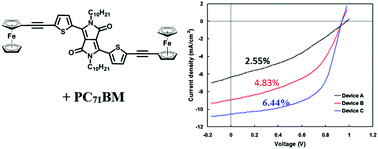Ferrocene-diketopyrrolopyrrole based small molecule donors for bulk heterojunction solar cells†
Abstract
A symmetrical D–π–A–π–D type small molecule consisting of thiophene flanked diketopyrrolopyrrole (DPP) as a core and an end capping ferrocene donor linked by an ethynyl bridge, denoted as Fc-DPP-Fc, was synthesized and its optical, thermal and electrochemical properties were investigated in order to explore its potential applicability as a donor for solution processed bulk heterojunction solar cells. The photophysical and electrochemical properties of this small molecule showed strong charge transfer interaction between the ferrocene donor and the DPP acceptor, and it is found to be suitable as a small molecule donor along with PC71BM as an electron acceptor for solution processed bulk heterojunction organic solar cells (OSCs). Although the open circuit voltage (Voc) of the OSC based on as cast Fc-DPP-Fc : PC71BM (1 : 2 weight ratio) from a THF solvent is quite high (0.98 V), it showed an overall power conversion efficiency (PCE) of 2.55% with low values of short circuit current (Jsc) and fill factor (FF) of 6.35 mA cm−2 and 0.41, respectively. After using a solvent additive (SA), i.e. 3 v% DIO/THF solution for film deposition, the resultant OSC showed an improved overall PCE of 4.83% and it further improved up to 6.44%. The improvement in the PCE value is mainly attributed to the enhancement in Jsc and FF, resulting from the increased light harvesting efficiency, balanced charge transport and favorable nanoscale morphology of the active layer, induced by SA and TSA.



 Please wait while we load your content...
Please wait while we load your content...